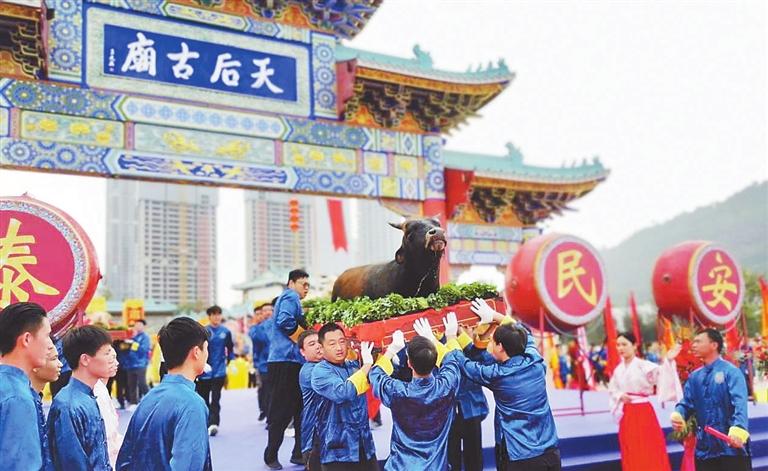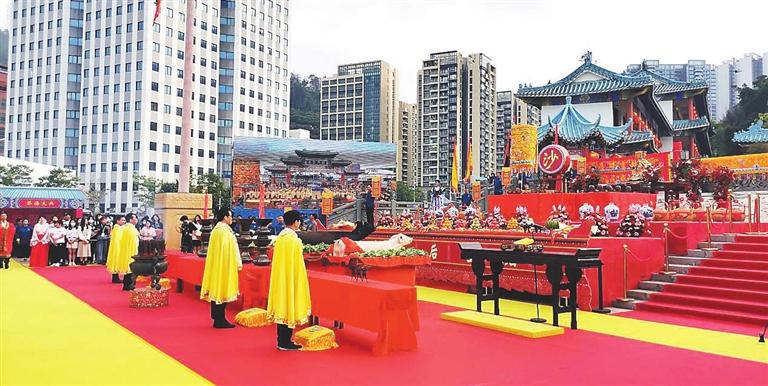

Cao Zhen caozhen0806@126.com “FAREWELL to the Sand” (辞沙), a 600-year-old folk custom to worship Mazu, the goddess of the sea, took place at Tianhou Museum near the Chiwan Port in Nanshan District on the morning of April 29, the first grand Mazu event at the museum since it became a national-level cross-Strait exchange base in February. More than 1,000 people from the mainland, Taiwan, Hong Kong and Macao attended the special ceremony that was hosted by the Shenzhen Municipal People’s Government’s Taiwan Affairs Office and Nanshan District People’s Government, organized by the Taiwan Democratic Self-government League’s Shenzhen Committee, Nanshan District Taiwan, Hong Kong and Macao Affairs Bureau, Nanshan District Culture, Radio, TV, Tourism and Sports Bureau, and co-organized by the Nanshan District Mazu Culture Exchange Association. Mazu, also known as Tianhou or Heavenly Queen, is the patron saint of seafarers and is highly respected in the coastal regions of southern China. The 23rd day of the third lunar month, falling on May 12 this year, is Mazu’s birthday. Every year, as her birthday approaches, various commemorative activities are held in coastal areas. The “Farewell to the Sand” ceremony is a unique folk custom of the Chiwan Tianhou Temple. Originating in the Ming Dynasty (1368-1644), the custom has been passed down for more than 600 years. Before the ceremony began at 7:30 a.m., representatives from Shenzhen and Taiwan exchanged Mazu-themed cultural artifacts. After welcoming the deity and reciting blessings, the worship guests boarded ships to send the sacrifice, a cattle skin stuffed with straw, to the sea. In ancient times, when emperors worshipped the gods, cattle, goats and pigs were used as sacrificial animals. The Chiwan Mazu ritual used to be performed on the beach; thus it is called “Farewell to the Sand.” In the early Ming Dynasty, the ritual was for imperial officials to worship the sea goddess and the sea before their envoys; from the mid-Ming through the early 20th century, more seafarers practiced this ritual in hope for Mazu’s blessing for safe voyages. Since 2014, “Farewell to the Sand” has been held at the Chiwan Tianhou Temple instead of on the beach due to the reclamation. This grand folk ceremony embodies people’s yearning for a better life and plays a vital role in uniting overseas Chinese. The “Farewell to the Sand” ceremony is also a Guangdong intangible cultural heritage. “We and Taiwanese compatriots share the same roots and the Mazu culture is an inseparable part of traditional Chinese culture,” said Zhou Baomin, head of the Nanshan District Culture, Radio, TV, Tourism and Sports Bureau. “We hope the two sides of the Strait can achieve mutual understanding and closer ties through the Mazu cultural exchange activities. Both sides will work together to make contributions to the great rejuvenation of China.” Many Taiwanese guests attended the “Farewell to the Sand” ceremony in Shenzhen for the first time. Impressed by the grand event, they said they would invite more Taiwanese people to join the Shenzhen event in the future and hope that both sides of the Strait can work together to promote exchanges and propel development. “Taiwanese compatriots will have a deeper understanding of the mainland through this activity,” said Chen Zhonghe, chairman of the Taiwan Merchants Association of Shenzhen. At another Mazu worshiping activity held April 27, many Taiwanese participants expressed that Mazu is a common belief of the people on both sides of the Strait, and by experiencing the worship on the mainland, they have deeply felt the shared cultural heritage between the two sides and hope to promote cultural exchanges to enhance mutual understanding. Fan Xuanting from Kaohsiung, who visited the mainland for the first time, said the mainland was different from what he imagined and he would introduce the mainland to his friends in Taiwan and also consider studying here in the future. Legend has it that Mazu lived in the 10th century on Meizhou Island in Fujian Province, where she dedicated herself to helping her fellow townspeople, and died attempting to rescue shipwreck survivors. Later, people worshiped Mazu incorporating a host of beliefs and customs. Deeply integrated into the lives of coastal Chinese, Mazu culture is an important bond that promotes family harmony, social peace and the cultural and ethnic identity of these communities, as well as an emotional bond to unite overseas Chinese. In 2009, the Mazu beliefs and customs were included on UNESCO’s intangible cultural heritage list. The original Tianhou Temple inside the Tianhou Museum in Chiwan was built by imperial order in the late Song Dynasty (960-1279) and was said to be as large as 600,000 square meters and have 99 gates. From 1405 to 1433, Chinese mariner and diplomat Zheng He commanded expeditionary treasure voyages to Southeast Asia, the Indian Subcontinent, Western Asia and East Africa. He was believed to have been protected by Mazu, so the temple was refurbished at that time. The old temple by the sea used to be an essential stop for ancient envoys traveling to Southeast Asia, and this “Farewell to the Sand” ritual was an important tradition. After several reconstructions in the past centuries, the temple now covers 28,000 square meters and the museum also enjoys overseas fame. In February this year, the Tianhou Museum was designated as a national-level cross-Strait exchange base along with eight other places in China. According to the Taiwan Affairs Office of the State Council, the designation provides more opportunities for compatriots on both sides of the Taiwan Strait to reflect on the past, experience the culture, improve their kinship and develop their economies together. | 
